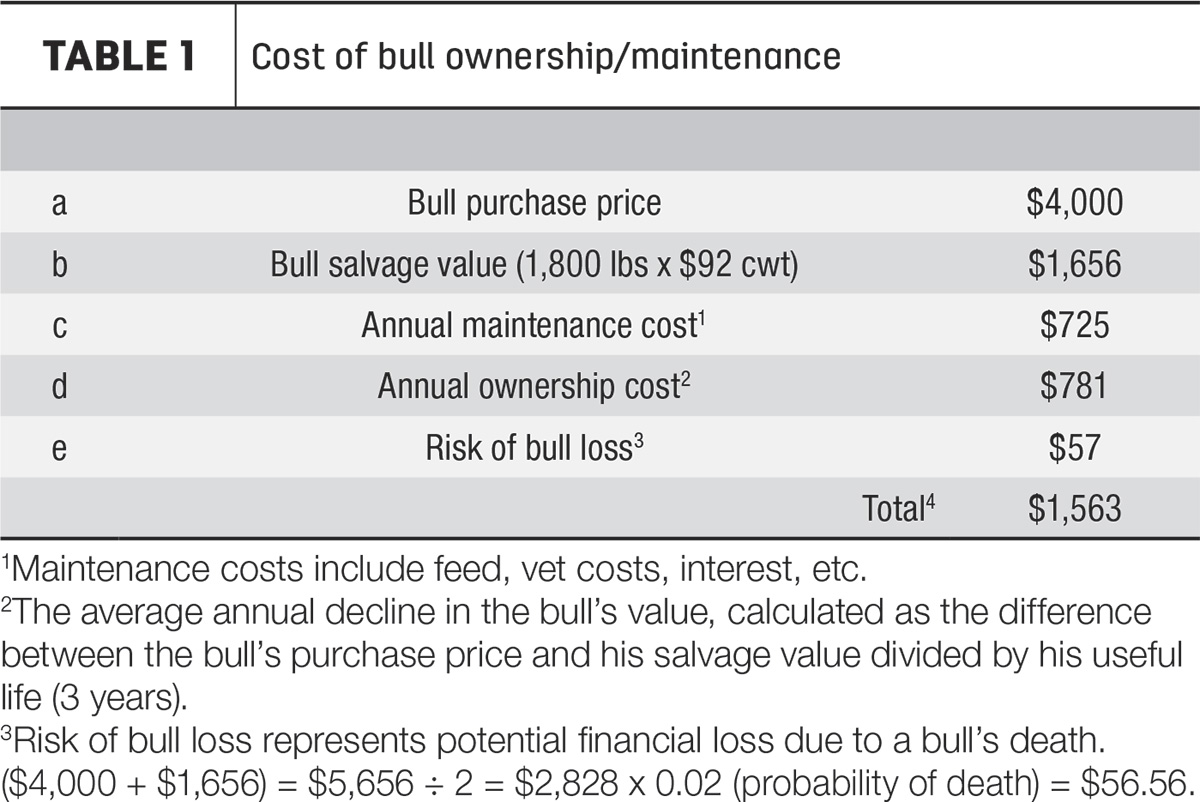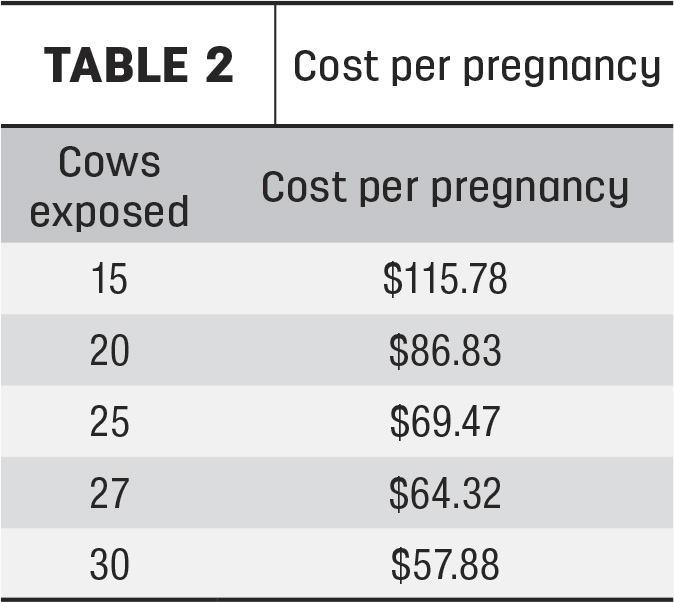Artificial insemination (A.I.) has been available to cattle breeders since the 1930s. The dairy industry was the first to take advantage of the new technology, with beef producers following later. A major detriment to the A.I. process was the need for accurate heat detection. In the 1960s, research with progesterone and prostaglandins began to show that the bovine estrus cycle could be manipulated, making A.I. a more attractive opportunity for beef cattle raisers.
Most beef producers don’t adopt A.I. as a practice because they think it will require more expense or the hiring of a professional. In Texas, the top-producing cattle state, only 5% of producers were found to be using it in their operations.
The use of 100% A.I. on range-type commercial cow-calf operations is not usually possible. One choice that many Western ranches make is to artificially inseminate their first-calf heifers. In some cases, it’s possible to synchronize the main cow herd and do a timed insemination before turning in cleanup bulls. Everything depends on accessible feed resources, available labor and facilities.
In most all cases, it is necessary to include an estrus synchronization protocol for artificial insemination to be most effective in commercial beef operations.
The information presented here will compare estrus synchronization plus A.I. with natural service.
Before the two strategies for breeding can be compared economically, it is necessary to consider the possible benefits of using a new-fangled technology such as synchronization and A.I. Cattle ranchers are not often inclined to move from something that is working to adopt a new idea that may or may not be beneficial. The following is a list of probable advantages of using synchronization/A.I. for beef producers to consider.
Controlled calving season
Controlling the length of the calving season using estrus synchronization is extremely important when considering first-calf heifers. These young females are not only maintaining a pregnancy and giving birth to a calf, but are also trying to sustain their own body functions and continue to grow to mature size. All of this dictates that they receive intensive human care prior to, during and after parturition. Being able to control the length of this intensive period can have lasting effects during the season and also throughout the reproductive lifetime of the female. One research study found that a well-designed synchronization and A.I. program can have an impact on the reproductive lifetime potential of cows.
Increased calf crop uniformity
More calves born early due to synchronization/A.I. reduces the number of late-born smaller calves at weaning. The result is increased value due to uniform age and size of the calves. Additionally, A.I. sires can be used to insure uniformity of breed, color and conformation. All of these factors enhance the value of the calf crop.
Increased weaning weight
Synchronization and A.I. can achieve more pregnant cows early in the breeding season. This means more calves born earlier in the year, leading to more pounds of beef at weaning time.
Increased reproductive performance
Cows that conceive earlier and calve earlier have a longer period to rebreed during the postpartum period and are less likely to be open and culled at weaning time.
Genetic enhancement
Artificial insemination gives a beef producer the opportunity to breed to sires that can enhance the genetic makeup of the cow herd in one generation. Producers can achieve rapid genetic progress using proven sires that are known to possess valuable traits such as growth, carcass quality and milk production.
Selection confidence
Utilizing genomically enhanced expected progeny difference (EPD) sires, breeders can select for key traits that can improve many aspects of production. These enhanced EPDs make the selection process much more accurate. Ranchers can pick bulls with the traits that are needed to improve their herd with a sense of confidence.
In times past, bull buyers would never think of purchasing without first seeing the bull in person. Most buyers never considered that because a bull had achieved personal growth and had desirable conformation, he may not pass those positive characteristics on to his progeny. Genomic-enhanced EPDs have taken some of the guesswork out of the selection process. Bulls can be safely selected on paper by the numbers without ever having a visual inspection.
Synch/A.I. vs. natural mating
Unfortunately, the definitive comparison of synch/A.I. vs. natural mating has not been accomplished. It is difficult to quantify many of the characteristics without the use of economic models based on a myriad of assumptions.
What follows is a simplified version of costs and returns associated with synch/A.I. versus natural mating. Despite the generalization of these figures, they still provide enough information for a producer to make a confident decision as to how this would impact a beef operation.
Natural mating
In a natural mating scheme, it can be assumed that one bull will cover 25 to 30 cows depending upon the breeding conditions. In an effort to compare the two strategies to get cattle pregnant, it is important to first establish the cost of natural service.
Table 1 illustrates the annual cost of bull ownership and maintenance. Many producers do not realize the expense of owning bulls. Not only feed, housing, veterinary care, but also interest on loans and risk of injury or death. Many veterinarians concur that the useful life of a bull should be three years due to health issues such as trichomoniasis.

Many producers do not realize the expense of owning bulls. Not only feed, housing, veterinary care, but also interest on loans and risk of injury or death. Many veterinarians concur that the useful life of a bull should be three years due to health issues such as trichomoniasis.
Table 2 shows the various costs of getting a cow pregnant using a bull with a $4,000 purchase price, annual bull ownership/maintenance costs of $1,563 and a three-year useful life in the herd.

Three years is the recommended useful life due to health issues such as trichomoniasis. These figures take into consideration a 90% conception rate for the average rangeland beef operation. Different conditions could affect the conception rate.
As the number of cows exposed increases, the cost per pregnancy becomes more cost effective. Based on the calculations shown, the cost of getting a cow bred by natural service ranges from $115.78 to $57.88 per cow as the number exposed approaches 30.
To achieve a successful conception rate, the cows in the herd need to be at or approaching a body condition score of 5. Cows losing weight or in a poor condition have a reduced chance of getting bred, whether by A.I. or natural mating.
Synch A.I.
Estrous synchronization protocols have been developed that enable the breeding and calving period to be contained, making A.I. more practical for beef producers.
The synchronization protocol or plan for this example is Cosynch using CIDRs. This protocol has been shown to be very successful and accepted in the beef industry. The same protocol can be used on heifers, however, there are several protocols to choose from depending upon time frame, facilities and finances. Table 3 shows the timeline and process of Cosynch. To investigate other protocols, visit the ABS Global website.

It is important to remember when using a synchronization program to pay strict attention to the directions of the protocol. Pregnancy rates can be very low if the facets of the protocol are not followed precisely.
Table 4 shows the individual costs of using Cosynch plus CIDRs on a mature cow herd. The cost would be the same for heifers.

The cost of pregnancy is calculated by multiplying the total cost of $52.50 by 27 and dividing the outcome by 16, the total number of calves with a 60% conception rate. The cost of pregnancy is $88.59. Immediately, red flags go up and beef producers panic at this figure. However, research has shown that A.I.-sired calves are estimated to be 10 days older and weigh 20 more pounds at weaning . The advantage of this will be shown in the section.
Comparison
Natural mating
For illustration sake, consider a herd of 27 cows that can be serviced by one bull. With a 90% conception rate and no death loss during the season, these 27 cows would wean 24 calves from natural service. With an average weaning weight of 550 pounds, the total weight would be 13,200. Using a standard 2% shrink, the net weight would be 12,936 pounds. At a pay weight of $1.80 per pound, total income from the 27 cows would be $23,285 or $970 per weaned calf.
Synch/A.I.
Now consider the same 27 cows, only in synch/A.I. program. Assuming a 60% conception rate, there would be 16 A.I. calves born. From the research cited above, these calves would be 10 days older and 20 pounds heavier. Multiplying the average weaning weight of 570 by 16 would mean 9,120 pounds of weaned calf from A.I. mating.
With this group of cows, it must be considered that the cleanup bull used after A.I. would bring the conception rate for the entire herd up to 90%. This means that there would be an additional eight calves from natural service. These calves would weigh 550 pounds because they were born later, for a total of 4,400 pounds. The total weaned pounds of calf from the 27 cows is 13,520 pounds, or an average weight of 563 pounds.
The target weight was 550 pounds at $1.80 per pound. Because the calves weighed 13 pounds more than expected, a 10% slide would come into effect. The price would become $1.7950, and including a 2% shrink, the pay weight would be 13,255 pounds. The total income from the calves would be $23,792.73 for an average of $991.36 per calf.
Conclusion
The results of this example have the synch/A.I. program resulting in a greater profit than natural service. In other situations, the outcome could move either direction depending upon the different circumstances. It has been suggested that the true economic difference between synch/A.I. and natural service is probably not huge. However, on a case-by-case basis, substantial differences undoubtedly exist.
The decision to participate in a synchronization/artificial insemination program depends mainly upon the goals of the beef producer. In general, estrus synchronization and A.I. are economically advantageous compared with natural service when a sufficient genetic value premium can be obtained from A.I.-sired calves.
Researchers continue to search for ways to economically characterize differences in performance and costs among the synchronization/A.I. and natural service options. Ultimately, producers should critically evaluate their own operation to determine which type of breeding system to use, taking into account their own production costs, need for genetic improvement and management capabilities.
References omitted but are available upon request. Click here to email an editor.







